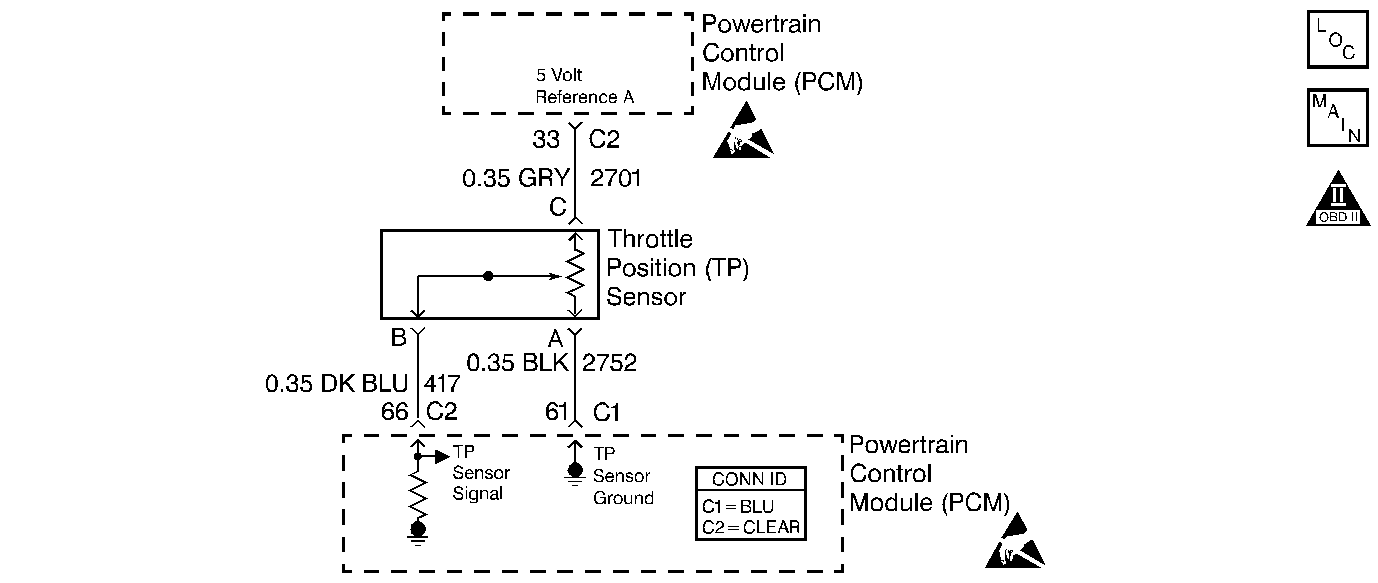
Circuit Description
The throttle position (TP) sensor circuit provides a voltage signal that changes relative to throttle blade angle. The signal voltage will vary from below 1.0 volt at closed throttle to above 4.0 volts at wide open throttle (WOT). If the PCM detects a TP signal voltage that is intermittently more than the range of the TP sensor, DTC P1121 will set.
Conditions for Running the DTC
The ignition is ON.
Conditions for Setting the DTC
TP sensor intermittently indicates a throttle position signal more than 4.9 volts.
Action Taken When the DTC Sets
The PCM stores conditions which were present when the DTC set as Failure Records only. This information will not be stored as Freeze Frame Records.
Conditions for Clearing the MIL/DTC
| • | The DTC becomes history when the conditions for setting the DTC are no longer present. |
| • | The history DTC clears after 40 malfunction free warm-up cycles. |
| • | The PCM receives a clear code command from the scan tool. |
Diagnostic Aids
Check for the following conditions:
| • | Poor connection at the PCM or sensor -- Inspect harness connectors for the following conditions: |
| - | Backed out terminals |
| - | Improper mating |
| - | Broken locks |
| - | Improperly formed or damaged terminals |
| - | Poor terminal to wire connection |
| - | Use a corresponding mating terminal to test for proper tension. |
| • | Damaged harness -- Inspect the wiring harness for damage. If the harness appears to be OK, observe the throttle position display on the scan tool while moving connectors and wiring harnesses related to the TP sensor. A change in the display will indicate the location of the malfunction. |
If the DTC cannot be duplicated and is determined to be intermittent, reviewing the Failure Records can be useful in determining when the DTC was last set. Also refer to Testing for Intermittent Conditions and Poor Connections in Wiring Systems.
Step | Action | Values | Yes | No |
|---|---|---|---|---|
1 | Did you perform the Powertrain On-Board Diagnostic (OBD) System Check? | -- | ||
2 |
Important: If DTC P1635 5 Volt Reference Circuit is set, perform that diagnostic first. Is DTC P0123 also set? | -- | Go to DTC P0123 Throttle Position (TP) Sensor Circuit High Voltage | |
3 | Is DTC P1115 and/or P1106 also set? | -- | ||
4 | Test all 5 volt reference A circuits and connected components for an intermittant short to voltage. Refer to Circuit Testing and Wiring Repairs in Wiring Systems. Did you find and correct the condition? | -- | Go to Diagnostic Aids | |
5 | Test the signal circuit of the TP sensor for an intermittant short to voltage. Refer to Circuit Testing and Wiring Repairs in Wiring Systems. Did you find and correct the condition? | -- | ||
6 | Test the ground circuit of the TP sensor for an intermittant open. Refer to Circuit Testing and Wiring Repairs in Wiring Systems. Did you find and correct the condition? | -- | ||
7 | Inspect for poor connections at the harness connector of the TP sensor. Refer to Testing for Intermittent Conditions and Poor Connections and Connector Repairs in Wiring Systems. Did you find and correct the condition? | -- | ||
8 | Inspect for poor connections at the harness connector of the PCM. Refer to Testing for Intermittent Conditions and Poor Connections and Connector Repairs in Wiring Systems. Did you find and correct the condition? | -- | Go to Diagnostic Aids | |
9 |
Does the DTC reset? | -- | System OK |
